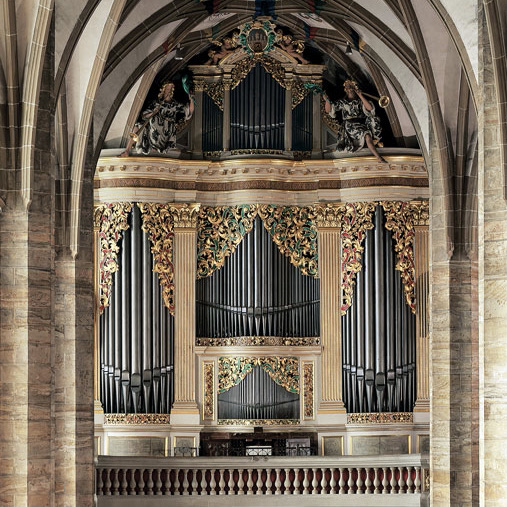SILBERMANN
Cathedral Freiberg
Organ details
History
THE GREAT ORGAN OF FREIBERG CATHEDRAL
BUILT BY GOTTFRIED SILBERMANN, 1714
RESTORED BY JEHMLICH 1981-83 AND 2009/10
After having served for several years as apprentice in his brother Andreas’ workshop in Strasbourg, Gottfried Silbermann returned to his native Saxony in 1710. That same year, the Council of Freiberg put an end to decades of deliberation and finally approved the project of having a new organ built for St. Mary’s Cathedral. Silbermann was barely 27 years old at the time, working on the project of his first “independent” instrument in his home town Frauenstein. In view of his already evident talent, the fact that he received the Freiberg commission to build a new three-manual organ in the Freiberg Cathedral was certainly not only due to recommendation on the part of Leipzig Thomaskantor Johann Kuhnau. The new organ was dedicated in 1714. In its conception (ingeniously combining the French-Alsatian and Middle German styles), in its excellent craftsmanship and in its astoundingly precise voicing, this instrument sports truly unique qualities. Here, in the Freiberg Cathedral Organ, Silbermann merged different styles in a way he would never repeat again. The French style of organ building is reflected in the overall specification, in the voicing of the reeds, and in the way the shallots and windchests were designed. The original blueprint even included a choir organ. On the other hand, the German style is reflected in the powerfully reinforced foundation stops, in the strong emphasis on pedal (although still lacking a coupler or the corresponding palletbox), as well as reinforced specification of Quintadehn stops and conical stops. Otherwise, until today, nothing in the specification has been modified. The original pitch, uncommonly high at ca. a=473 Hz, has been preserved (now at 476 Hz) along with the unequal temperament. Studying those few pipes which have not undergrone some kind of modification, it can be assumed that the Silbermann organ was tuned in a temperament closely resembling mean-tone. Following several retunings in the course of the 20th century, the latest historical restoration 1985 establisht a greatly modified (well-temperated) mean-tone temperament, which has been maintained since then.
The fact that this Great Silbermann Organ is particularly well preserved can be attributed to several factors. His apprentices kept up its maintance during his lifetime, although he had forbidden them to do so (since he had a permanent disagreement with the Council of Freiberg). The fact that Silbermann and his successors and pupils Johann Georg Schöne and Adam Gottfried Oehme had their workshop on the Schlossplatz – within eyeshot of the Cathedral – was certainly also of great advantage. Inscribed on the walls of the so called Kurrendekammer (“choir chamber”) in back of the organ and in the bellows, one will find a great number of names of many who helped maintain and preserve the instrument ever since the 1700’s. Attempts to re-tune the instrument in the course of the 1800’s fortunately came to nought: the first time due to “lacking finances” in 1841, then thanks to resistance on the part of both the Cathedral Organist and the Kantor in 1853. During his first years as Cathedral Organ is from 1926 on, Arthur Eger was also able to protect the organ from being rebuilt. Modifications were only made in the wind supply; then, in 1933, the Quintadehn 8'stop was rebuilt due to supposed tin disease, and the reeds were somewhat ’redone' in 1939. Then, in the 1950’s, the wind supply was restored back to its approximate state before modification. Finally, from 1981 to 1983, the Dresden organ building firm Jehmlich was entrusted with the major historical restoration, carried out by their specialist Kristian Wegscheider. The pipes and the wind supply were restored as much as possible back to their original condition, and the original mean-tone temperament was in a modified mode reinstadet. In 2009 and 2010 the bellows are undergoing a restoration. This has reinstated all six historical wedge-bellows to their original function, making human-powered blower air supply available as an alternative option to the electric motor.
Albrecht Koch
Multimedia library
Specification
| I. Brustwerk C, D-c3 | II. Hauptwerk C, D-c3 | III. Oberwerk C, D-c3 | Pedal C, D-c1 | |
| Gedackt 8 Principal 4 Rohrflöt 4 Nassat 3 Octava 2 Tertia Quinta 1 1/2 Sufflöt 1 Mixtur III | Bordun 16 Principal 8 Viola di Gamba 8 Rohrflöt 8 Octava 4 Quinta 3 Sup. Octav. 2 Tertia Cornet V Mixtur IV Zimbelin III Trompet 8 Clarin 4 | Quintadehn 16 Principal 8 Gedackt 8 Quintadehn 8 Octava 4 Spitzflöt 4 Sup. Octav. 2 Flaschflöt 1 Echo V Mixtur III Zimbeln II Krumbhorn 8 Vox Humana 8 | Untersatz 32 Princ. Bass 16 Sub Bass 16 Octav Bass 8 Octav Bass 4 Ped. Mixtur VI Posaun Bass 16 Tromp. Bass 8 Clar. Bass 4 | Couplers: III/II I/II Tremulant Pitch: a1 = 476,3 Hz modifiziert mitteltönig |




